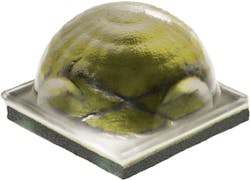Cree announces new LED architecture and brighter components
The SC5 LED technology platform will double the lumen output of packaged LEDs, according to Cree, and deliver 40% cost savings at the solid-state lighting (SSL) system level.
Cree has announced a new LED architectural platform that the company calls SC5 (silicon carbide 5) and that the company said will double flux output of prior-generation packaged LED components. The announcement included a new LED family branded Extreme High Power (XHP) and the first LED based on the SC5 technology platform, the XHP50, that can deliver 2250 lm in a discrete 5×5-mm package.
As noted above, the SC in the platform name is for silicon carbide (SiC), the material that Cree alone uses as a substrate for packaged LEDs. The company has consistently maintained that SiC offers advantages in flux output over sapphire-based LEDs without the premium cost of other non-sapphire substrates such as gallium nitride (GaN).
Cree first used the SC branding in the spring of 2012 when it launched the MT-G2 LEDs. At the time the company had said that the SC3 (SC cubed) brand equated to the third generation of its SiC technology. The first LEDs built on the platform were announced earlier in 2012 in the XB-D platform although the SC3 brand would not become public for several months.
Cree has since said that the 3 designator in SC3 did not equate to third generation. Still, SC5 almost certainly implies that the company believes that it has skipped a generation in terms of technology advancement. But the superscript designator is missing, perhaps given the lack of a convenient way to pronounce the new brand beyond "SC five."
As before, Cree said advancements in the new platform span the range of epitaxial structure, chip architecture, and light conversion. The result is presumably improved optical and thermal performance. As you can see in the nearby image, the first LED in the XHP family looks decidedly different from most earlier Cree LEDs. The device is apparently based on four die with the phosphor applied on each die.
Cree said LEDs based on the new platform will reduce solid-state lighting (SSL) system cost by 40% based on the need for fewer LEDs and less costly optical and thermal components, and manufacturing. The company covered similar ground when it announced the MH-B LED family.
Providing an example of how the new LEDs can deliver on cost savings, Cree said that a 120-mm-diameter PAR lamp can be replaced by a 30-mm lamp based on the new XHP LEDs with equivalent light output. The company said a single XHP LED can replace 48 mid-power LEDs.
"As a technology company, we’re focused on breaking the performance barriers that really matter to the lighting industry," said Chuck Swoboda, Cree chairman and CEO. "The SC5 Technology Platform redefines what is possible in high-power LEDs by doubling the lumens out of a single LED, giving lighting manufacturers the flexibility to innovate significantly lower-cost systems. This new platform establishes a new benchmark for LED lumens per wafer, which we believe will define the long-term success of our industry. This also validates our belief that high-power LED technology enables the best lighting system designs and a better lighting experience for end customers."
Cree has not released full specs for the new XHP50 LED. The company did say the LED is designed for 50,000 hours of life to L90 (90% of initial lumen output), even at high temperature and current drive. And the claim of double flux is relative to the Cree XM-L2 LED that it says was previously the brightest single-die LED on the market. Samples of the XHP50 are available now with high volumes due by year end.

Maury Wright | Editor in Chief
Maury Wright is an electronics engineer turned technology journalist, who has focused specifically on the LED & Lighting industry for the past decade. Wright first wrote for LEDs Magazine as a contractor in 2010, and took over as Editor-in-Chief in 2012. He has broad experience in technology areas ranging from microprocessors to digital media to wireless networks that he gained over 30 years in the trade press. Wright has experience running global editorial operations, such as during his tenure as worldwide editorial director of EDN Magazine, and has been instrumental in launching publication websites going back to the earliest days of the Internet. Wright has won numerous industry awards, including multiple ASBPE national awards for B2B journalism excellence, and has received finalist recognition for LEDs Magazine in the FOLIO Eddie Awards. He received a BS in electrical engineering from Auburn University.





